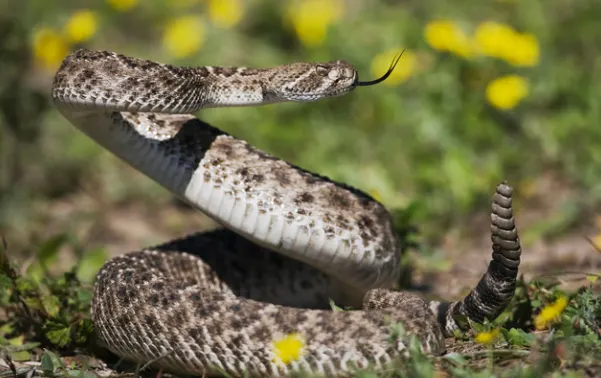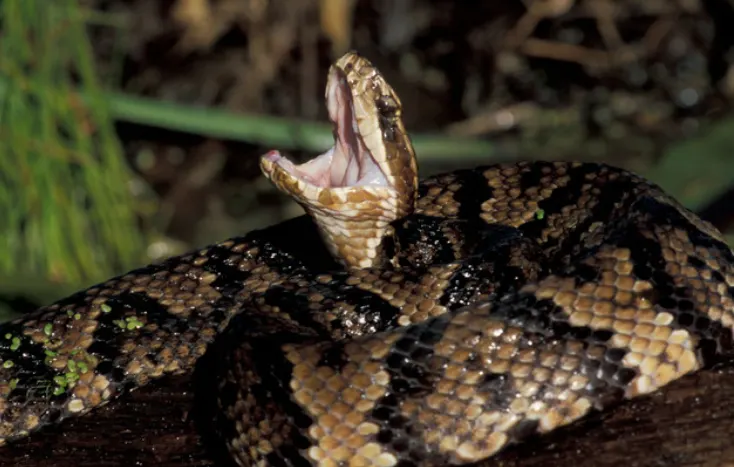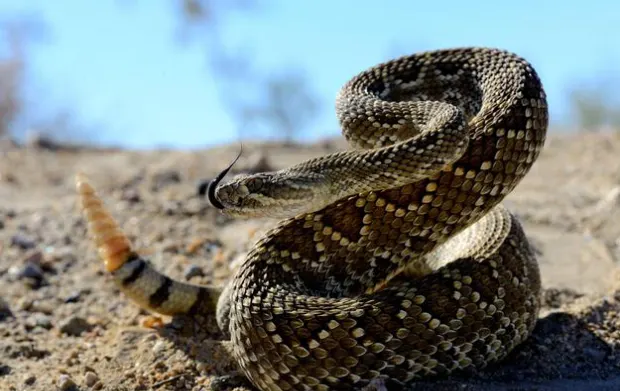Venomous snakes, with their potent brew of toxins, strike a balance between fascination and fear. This article delves into the realm of the ten most venomous snakes in the United States, a topic crucial for those traversing the diverse landscapes where these serpents silently roam. As we explore these venomous wonders, it’s essential to recognize the global diversity of venomous snakes and understand the criteria guiding our rankings.
Our ranking hinges on multiple factors, primarily focusing on the potency of venom and the potential danger these snakes pose to humans. From neurotoxic terrors to hemorrhagic assailants, each snake’s venomous arsenal contributes to its placement in this exclusive list.
Table of Contents
1. Eastern Diamondback Rattlesnake

Scientific Name: Crotalus adamanteus
Description: The heavyweight of North American snakes, boasting diamond patterns and a formidable rattle.
Venom Characteristics: Hemorrhagic venom causing internal bleeding and cardiac issues.
Geographical Range: Dominating the pine forests, mountains, and marshes of the Southeastern U.S.
Danger to Humans: With a fatality rate of 10-20%, caution is paramount.
Anti-venom Availability: CroFab anti-venom is effective but prompt intervention is crucial.
2. Western Diamondback Rattlesnake

Scientific Name: Crotalus atrox
Description: Distinguished by a brownish base with cream diamond patterns, the Western Diamondback is a robust and adaptable rattler.
Venom Characteristics: Though somewhat less toxic, it delivers substantial venom, causing severe muscle deterioration and internal bleeding.
Geographical Range: From the Southeast to California, thriving in various terrains.
Danger to Humans: With a 20% fatality rate, it trails closely behind its Eastern relative in annual fatalities.
Anti-venom Availability: While anti-venom is available, the snake’s aggressive nature makes caution paramount.
3. Coral Snake (Eastern and Western)

Scientific Names: Micrurus fulvius (Eastern) and Micruroides euryxanthus (Western)
Description: Sporting the classic black, red, and yellow bands, these nocturnal snakes boast potent neurotoxic venom.
Venom Characteristics: A powerful neurotoxin affecting the nervous system, with anti-venom availability being limited.
Geographical Range: From the southern U.S. into Mexico, preferring dry rocky areas (Western) and leafy forests (Eastern).
Danger to Humans: Though bites are rare, the potential fatality rate is high, emphasizing the need for caution.
Anti-venom Availability: Limited availability since Wyeth discontinued production in 2010.
4. Copperhead Snake

Scientific Name: Agkistrodon contortrix
Description: A stout pit viper with distinctive hourglass patterns, the Copperhead thrives in the eastern U.S.
Venom Characteristics: While its venom is mild, bites are rarely fatal but can be painful.
Geographical Range: Along the Eastern Seaboard, from New York to Nebraska.
Danger to Humans: Non-aggressive, but bites can cause pain; anti-venom is available but seldom used.
5. Cottonmouth Snake

Scientific Name: Agkistrodon piscivorus
Description: Also known as the water moccasin, identified by its semi-aquatic nature and a distinctive open-mouth warning display.
Venom Characteristics: More potent than the Copperhead, but fatalities are rare.
Geographical Range: Marshes, swamps, and streams from the Southeast to the Midwest.
Danger to Humans: Aggressive when threatened; bites are rare but can be more severe.
Anti-venom Availability: Anti-venom exists but is rarely needed.
6. Yellow-Bellied Sea Snake

Scientific Name: Pelamis platura
Description: An ocean-dwelling species with potent venom, the yellow-bellied sea snake is rarely seen on land and prefers warm waters.
Venom Characteristics: Highly potent venom with no known fatalities in the U.S., primarily found in the Pacific and Indian oceans.
Geographical Range: Frequents Pacific waters from Washington to South America, avoiding fresh water.
Danger to Humans: No reported U.S. fatalities, but venom is highly potent; envenomation is exceedingly rare.
Anti-venom Availability: Due to rarity of bites, no specific anti-venom; tiger snake anti-venom may be effective.
7. Timber Rattlesnake

Scientific Name: Crotalus horridus
Description: Known for its iconic rattle, the timber rattlesnake is one of the largest in North America, with variable venom toxicity.
Venom Characteristics: Venom toxicity varies by region, with some populations exhibiting primarily hemorrhagic venom.
Geographical Range: Densely populated northeastern U.S., once common but now extinct in some areas.
Danger to Humans: Considered life-threatening due to large size, long fangs, and potential for massive venom delivery.
Anti-venom Availability: Effective anti-venom available for prompt treatment.
8. Mojave Rattlesnake

Scientific Name: Crotalus scutulatus
Description: Similar in appearance to the Western Diamondback, the Mojave rattlesnake is known for its extremely toxic venom.
Venom Characteristics: Venom contains neurotoxins and is considered more toxic than some famed snakes, like the tiger snake.
Geographical Range: Southern areas of Arizona, California, Utah, New Mexico, and parts of Texas.
Danger to Humans: Highly aggressive with potentially underestimated peril due to less initial distress; prompt anti-venom is crucial.
Anti-venom Availability: Effective anti-venom based on Mojave rattlesnake venom is available.
9. Eastern Massasauga Rattlesnake

Scientific Name: Sistrurus catenatus
Description: The Eastern Massasauga, also known as the black rattlesnake, is a smaller rattlesnake species found in northern regions.
Venom Characteristics: Possessing moderately toxic venom, there is limited availability of specific anti-venin; however, bites are rarely fatal with prompt treatment.
Geographical Range: Inhabiting northern regions, including areas such as Ontario, Michigan, and the upper Missouri valley.
Danger to Humans: Generally non-aggressive, bites pose a risk but seldom result in fatalities.
Anti-venom Availability: Treatment typically involves the use of generic rattlesnake anti-venins.
10. Sidewinder

Scientific Name: Crotalus cerastes
Description: Known for its distinctive sidewinding movement, the Sidewinder adapts to desert environments.
Venom Characteristics: Possesses a potent venom that causes tissue damage and can be harmful to humans.
Geographical Range: Found in arid regions of the southwestern U.S., particularly in desert landscapes.
Danger to Humans: While fatalities are rare, bites can be painful and lead to medical complications.
Anti-venom Availability: Anti-venom is available but seldom required.
In the intricate tapestry of venomous snakes across the United States, each species tells a story of adaptation, survival, and the delicate balance between wildlife and humanity. Through understanding, awareness, and a healthy dose of caution, we can navigate these ecosystems respectfully. The serpentine inhabitants, from the mighty rattlers to the elusive sea snake, remind us of the wonders and challenges present in the wild corners of our nation. Stay informed, stay safe, and let the coexistence continue.
- Enchi Ball Python: A Unique and Stunning Morph of Python regius - March 27, 2025
- Emerald Tree Monitor: The Enigmatic Green Guardian of the Rainforest - March 26, 2025
- The Egyptian Cobra (Naja haje): A Fascinating Serpent - March 25, 2025
